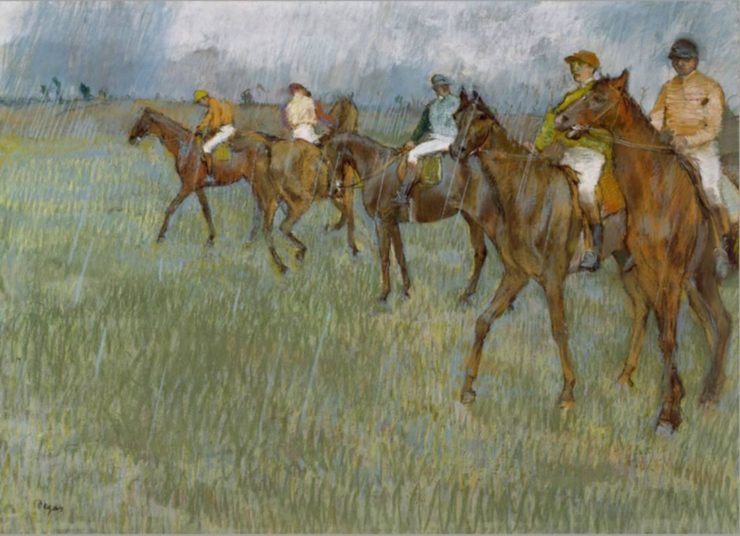Changes of seasons are hard on a horse. There are plenty of challenges in the dead cold of winter and the gasping heat of summer, but the seasons between run a sometimes impossible gamut of temperatures and conditions. When it’s 95F/35C and ferociously sunny on Sunday and 50/10 and pouring cold rain on Tuesday, the horse’s system may not be able to keep up.
The main defense a horse has against extremes of temperature is its coat. The short, close coat of summer allows heat to escape and lets the horse sweat freely to cool itself off. In winter, most horses grow a thick, long coat with an insulating underlayer and a protective outer layer. Rain and wind can flatten it and eliminate its protection, but dry cold and snow are what it’s made for. You can see horses in snow country standing happily out in the storm with snow piled on their backs, warm and comfortable inside their coats.
Horses in warmer climates, or in climates that tend toward extremes, don’t always do so well. In spring or fall, when the extremes are even more so, there’s no time for them to adapt. It takes weeks for the winter to coat to shed, and weeks more for it to grow back. Meanwhile temperatures are swinging, sun and rain are coming and going, and the horse may deal with it, or they may not. There’s a reason why sudden changes of weather are referred to as “colic weather.” Horses get sick and may die even under treatment.
Humans build barns not only to keep horses under control but to protect them from the elements. Heated or cooled barns are generally considered an extravagance; it’s not a bad thing to protect horses from extremes of heat or cold, or from wind or hard rain, but a well-designed and insulated barn maintains a comfortable temperature from the body heat of the horses in it, and likewise in hot weather, good ventilation and judicious placement of fans can go a long way toward making the weather bearable.
Buy the Book


All the Horses of Iceland
But horses are creatures of the wide outdoors. They need exercise and plenty of it. They may be kept inside in very bad weather, but most barn managers at least try to get them out as much as space allows.
Hence, horse blankets. The original model was a literal blanket, usually made of wool or cotton or canvas with strings or straps to keep it on the horse. With the advent of modern fabrics and technology, the horse blanket became a whole industry. Different designs, different weights and fills for different temperatures, different configurations for different conditions.
The waterproof blanket was a great advance, but the waterproof and breathable blanket was a triumph. At last, a blanket the horse could wear without sweating itself to death, but also without getting soaked if they stood out (as horses love to do) in the pouring rain. Not only that, these new blankets were amazingly lightweight even when wet, which made blanketing much easier on humans wrangling multiple yards of fabric, fill, and straps onto and around a large, moving target.
It’s a wonder and a marvel. It’s also a bit of a controversy, as some horsepeople maintain that horses are better off going it au naturel regardless of the weather. They survive in the wild. They can survive in captivity. Blanketing messes up their adaptation to wet or cold.
The trouble is, adaptation takes time. They have to grow or shed enough coat for broader climatic shifts. In the shorter term, as temperatures go up and down, they need time to adjust. In midsummer, when it’s 95/35 consistently, they’re comfortable as long as they have enough water and shade. In midwinter, when it’s below freezing for days and weeks, their heavy coats keep them nice and warm. But what if it swings from hot to cold and back again? What do they do then? And what happens if it’s 40/4 and raining sideways, and their coats are pounded flat and there’s nothing to keep the cold out?
This is especially applicable in the spring. Modern horses whose humans believe in blankets have accumulated whole wardrobes calibrated to different conditions.
There’s the waterproof and breathable rain sheet or raincoat, or anorak if you will, which keeps the horse dry (and clean) without adding warmth, though if they happen to have it on when the sun is out, they’ll gain some heat under the fabric. Then there are the mild-weather blankets with a little bit of polyfill, which may add a few degrees of warmth in iffy weather, while also keeping the horse dry if it’s raining. From there you shift to the midweights, designed for warmth in the ranges from freezing up to about 50/10. And then if you’re in a truly cold climate, you’ll keep a heavyweight on hand to keep the horse toasty when the thermometer drops to arctic levels.
A lot depends on how much coat the horse has under the blanket. A thin-coated horse will need more help than one with a lot of floof; the latter may only need a sheet to keep the rain off and keep the coat working. Horses in working or show barns may be clipped in winter to keep them from becoming overly sweaty when they’re worked, but when they’re resting in stalls or outside, they’ll need blankets as a substitute for their natural winter coats.
Come spring, when all healthy horses shed, a late attack of winter weather may find them without enough natural protection. Then they’ll welcome a blanket. And they do: they’ll sidle up and position themselves for easier application, and if you don’t get there fast enough, you may find the horse has pulled the blanket off the fence and tried to put it on themself.
The dilemma comes when it’s 80/27 today and the forecast is for 45/7 and rain overnight. Do you melt the horse at dinnertime so they’re warm at sunup? Do you put a sheet on so at least they’ll be dry? Will it be enough? Will the rain not come and the temperature not drop, or will it not only come, it turns to snow and gets seriously cold? Is your horse fine with that, or are they a delicate flower of equine nobility who cannot endure the thought of being, holy Epona, cold?
One thing you can do is feed extra hay, and you can add a warm bucket of soup to that. The traditional bran mash is no longer in vogue; it’s nutritionally suspect and may be harmful. But it’s still possible to mix a nice broth of the horse’s preferred feed, or even to wet the hay with warm water, which warms the horse from the inside out.
Then when it’s warm again, the blanket can come off, the hay and feed ration can drop down to normal levels, and the human can hope that the horse has literally weathered the storm. Until the next one. And then in due time it’s summer, with a whole new set of challenges.
Judith Tarr is a lifelong horse person. She supports her habit by writing works of fantasy and science fiction as well as historical novels, many of which have been published as ebooks. She’s written a primer for writers who want to write about horses: Writing Horses: The Fine Art of Getting It Right. She lives near Tucson, Arizona with a herd of Lipizzans, a clowder of cats, and a blue-eyed dog.










